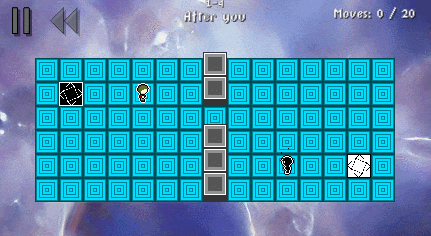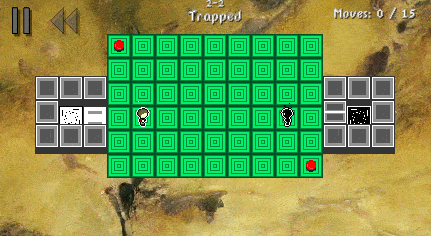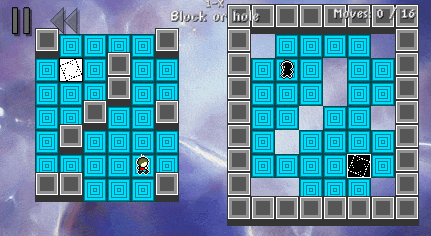A beginner's approach to puzzle design
Intro
As a beginner game developer, I usually find myself questioning if what I'm doing is right. I mostly end up doing whatever I find enjoyable, and that works well enough for me.
Recently I decided to create my first ever puzzle-focused game, as some of my all time favorite games are puzzle games (baba is you, the witness, the talos principle).
In these games, my enjoyment comes from theorycrafting and eventually finding the solutions. But when creating a puzzle, I necessarily know the solution beforehand, so I had to change my usual design strategy. In this post I want to explain how I went about it. Hope you find it interesting!
If you want to avoid "spoilers" for the game, feel free to check it out before continuing (free and playable on browser):
https://asdehielo.itch.io/the-soul-maze
The rules
If you have played the game, you may skip this part.
Here is a gif of the first level to get a general idea of what the game is. Basically, it's a game where you move 2 characters in a grid at the same time (body and soul).

As any other game, this one has its own set of rules. These are explicitly told to the player at the beginning of the first level:
- You control your body and your soul at the same time. Your soul will move the opposite direction of your body (so if you move right, the soul will move left)
- To complete a level, your body must be on the white exit and your soul on the black exit.
- Any ground below your soul will disappear.
- Neither body nor soul can step where there is not ground.
However, there is another rule that is not told explicitly, and players should figure it out on their own:
- If a character's movement is blocked by an obstacle, the other character will still perform its movement.
Say, if you try to move the body upwards but there is a wall, your soul will still move downwards (as long as there isn't another obstacle). This is extremely important, as most of the solutions revolve around aligning body and soul using the various obstacles.
Now that the rules are set, we can move on to my design approach.
My approach
The idea
I always start with a general idea. This can be basically anything. Let's take a look at level 1-4:

My idea here was: "A level in which both characters must go through a single path".
In this level, the player should quickly realize that the body must go first, as the soul would destroy the only path. After that, the characters must be realigned.
Building the level
Once the idea is settled, I start by building a generic, sort of random layout in which my intended solution is possible. Then, I sculpt the level, meaning I delete as much of it as I can until my solution is the only possible one (or at least the optimal one, so as to give some level of freedom).
Outside the box solutions
Sometimes, the idea requires a solution that is different to what the player has learned. Take for example level 2-2:

My idea for this level was: "The solution should involve one of the characters getting trapped so the other one can move freely".
Whenever these sort of "new" mechanics were introduced, I placed some subtle tips in the form of level names, which is something many puzzle games do. In this one, my testers would cluelessly move around until they read the level name. Then, they would immediately try to trap one of the characters as intended.
Trial and error
Other times, my idea would be much more abstract, like in 1-X: "A level in which body and soul are in different islands, with holes and walls in inverse positions":

As you can see, there are 2 possible paths the player can take at the start of the level. However, one of them does not lead to a solution. The player has no way of knowing this without trying and failing. I'm generally not a fan of trial and error puzzles, as they are either uninteresting or frustrating to me. But in this case, I felt like the undo feature greatly reduced frustration, and the fact that it was different to every other level made it at least somewhat interesting.
Too much trial and error
So I conceded that trial and error is not that bad. After all, I thought of it as a game of chess: to find the best move, you try different moves in your head, and discard those that are a mistake, effectively reducing the possibilities and making the decision much easier. But what if there are too many possibilities?
In chess this is not a problem, as you are generally not looking for the perfect movement, just one that gives you an advantage. And even if you make the wrong move, it doesn't always mean you will lose.
But in a single player puzzle game, you need to find the perfect movement in order to win the game. If you don't find it, all you get is frustration. This is what happens in the final level of the game. I will not spoil it, but I'll say it's much bigger than any other level. And while there's some logic behind the solution, it mostly requires a huge amount of trial and error, and all of my testers would just give up and ask me to solve it for them. I consider this a failure in puzzle design, but I still decided to leave it as is, because it feels like a fitting ending for the game and maybe a very passionate player would enjoy such a challenge.
Conclusion
To sum up, my design process for the puzzles in this game consisted in "Idea -> Build -> Sculpt". The biggest flaw, in my opinion, is that the concept of "Idea" is too wide, and clearly not every idea is equally fit for a puzzle. Perhaps the way to go would be to only implement those that are more defined, like the ones for level 1-4 and 2-2, and discard the more asbtract ones, like in 1-X.
So what is the correct approach to puzzle design?
Every game is different, and my experience is very limited, so I can't give a definitive answer. However, there are 2 main points that I've found the most enjoyable puzzles have in common:
- It must be possible to logically explain the solution to the puzzle.
- The puzzle cannot be solved by trial and error (or it's in no way an optimal strategy).
Hope you enjoyed reading, let me know your thoughts!
Get The soul maze
The soul maze
Solve puzzles with your soul
| Status | Released |
| Author | Raul Moreno Tamayo |
| Genre | Puzzle |
| Tags | 2D, Pixel Art, Short, Singleplayer |

Leave a comment
Log in with itch.io to leave a comment.